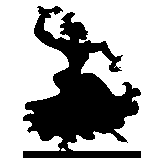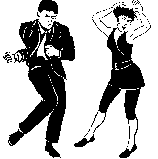 Dance,
patterned and rhythmic bodily movements, usually performed to music, that serve as a
form of communication or expression. Human beings express themselves naturally through movement. Dance is the transformation of ordinary functional and expressive movement into extraordinary movement for extraordinary purposes; even a common movement such as walking is performed in dance in a patterned way, perhaps in circles or to a special rhythm, and it occurs in a special context. Dance may involve a fixed vocabulary of movements that have no meaning in themselves, as in much of ballet and European folk dance, or pantomime and symbolic gestures may be used, as in many Asian dance forms. Peoples of different cultures dance differently and for varying purposes; their varied forms of dance can reveal much about their way of life.
Dance,
patterned and rhythmic bodily movements, usually performed to music, that serve as a
form of communication or expression. Human beings express themselves naturally through movement. Dance is the transformation of ordinary functional and expressive movement into extraordinary movement for extraordinary purposes; even a common movement such as walking is performed in dance in a patterned way, perhaps in circles or to a special rhythm, and it occurs in a special context. Dance may involve a fixed vocabulary of movements that have no meaning in themselves, as in much of ballet and European folk dance, or pantomime and symbolic gestures may be used, as in many Asian dance forms. Peoples of different cultures dance differently and for varying purposes; their varied forms of dance can reveal much about their way of life.
 Dance and Human Culture
Dance can be art, ritual, or recreation. It goes beyond the functional purposes of the
movements used in work or athletics in order to express emotions, moods, or ideas; tell a
story; serve religious, political, economic, or social needs; or simply be an experience that
is pleasurable, exciting, or aesthetically valuable.
Dance and Human Culture
Dance can be art, ritual, or recreation. It goes beyond the functional purposes of the
movements used in work or athletics in order to express emotions, moods, or ideas; tell a
story; serve religious, political, economic, or social needs; or simply be an experience that
is pleasurable, exciting, or aesthetically valuable.
Dance and the Human Body
The body can perform such actions as rotating, bending, stretching, jumping, and turning.
By varying these physical actions and using different dynamics, human beings can devise
an infinite number of body movements. Out of the range of movements that the body is
capable of performing, every culture emphasizes certain features in its dance styles.
The ordinary potential of the body can be expanded in dance, usually through long periods
of specialized training. In ballet, for example, the dancer exercises to rotate, or turn out,
the legs at the hips, making it possible to lift the leg high in an arabesque. In India, some
dancers learn to choreograph their eyeballs and eyebrows. Costuming can extend the
body's capabilities. Toe or pointe shoes, stilts, and flying harnesses are a few of the
artificial aids employed by dancers.
 The primary elements of dance include (1) the use of space—floor patterns, the shapes of
the moving body, and designs in space made by the limbs; (2) the use of time—tempo, the length of a dance, rhythmic variations, and the attitude toward filling time, from taking
one's time to making quick stops and starts; (3) the use of the body's weight—overcoming
gravity to execute light, graceful movements, surrendering to gravity with heavy or limp
movements, or exerting the body's weight against gravity with strength; and (4) the use of
energy flow—tense, restrained, or bound movements or freely flowing motion.
The primary elements of dance include (1) the use of space—floor patterns, the shapes of
the moving body, and designs in space made by the limbs; (2) the use of time—tempo, the length of a dance, rhythmic variations, and the attitude toward filling time, from taking
one's time to making quick stops and starts; (3) the use of the body's weight—overcoming
gravity to execute light, graceful movements, surrendering to gravity with heavy or limp
movements, or exerting the body's weight against gravity with strength; and (4) the use of
energy flow—tense, restrained, or bound movements or freely flowing motion.
 Dance and the Human Mind
Besides giving physical pleasure, dancing can have psychological effects. Feelings and
ideas can be expressed and communicated; sharing rhythms and movements can make a
group feel unified. In some societies, dancing often leads to trance or other altered states
of consciousness. These states can be interpreted as signaling possession by spirits, or they
may be sought as a means to emotional release. A state of trance may enable people to
perform remarkable feats of strength, endurance, or danger, such as dancing through hot
coals. In some societies shamans dance in trance in order to heal others physically or
emotionally. The modern field of dance therapy developed as a means to help people
express themselves and relate to others.
Dance and the Human Mind
Besides giving physical pleasure, dancing can have psychological effects. Feelings and
ideas can be expressed and communicated; sharing rhythms and movements can make a
group feel unified. In some societies, dancing often leads to trance or other altered states
of consciousness. These states can be interpreted as signaling possession by spirits, or they
may be sought as a means to emotional release. A state of trance may enable people to
perform remarkable feats of strength, endurance, or danger, such as dancing through hot
coals. In some societies shamans dance in trance in order to heal others physically or
emotionally. The modern field of dance therapy developed as a means to help people
express themselves and relate to others.

